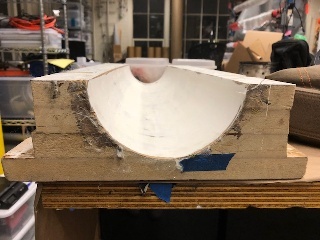
Above: Hermes 1 nose cone mold (4 layers of 1" thick MDF, sanded and finished with gel coat), manufactured by Raul Largaespada.
Overview of Nose Cone Design
Hypersonic optimum with a 2" straight section for the payload coupler
5.5:1 fineness ratio
10 layers of fiberglass, around 0.125"
NC tip material: __________
What size bolt?
Phenolic washer
Fiberglass Nose Cone Manufacturing Procedure
Overview of Nose Cone Design
Shape, materials, length, fineness ratio, tip dimensions and material, washer, bolt, method for attaching thermocouples, etc.
*remember that you need TWO halves of the mold.
Talk about mold materials used (MDF, gel coat), why fiberglass used
Hypersonic optimum not tangent to linear section so chose some radius in Solidworks (should calculate minimum radius to avoid shock waves)
Overview of Mold Design
Each half of the mold: 5 layers of 3/4" MDF (total thickness: 3.75"). Since the radius of the nose cone is 3", this gives us an extra 0.75" on the bottom. The top view of the mold measures [ x ], accounting for space on either side of the nose cone
Alignment pins, pry slits
Manufacture Mold
To route the mold we are using the router in Gelb (next to Todd's shop). You will need an STL file of your nose cone mold. Make sure to wear a dust mask while routing and use the vacuum because a LOT of dust will be generated.
Required Materials:
- 3/4" or 1" thick MDF (we used 3/4")
- Epoxy (WHAT KIND)
- Pins (??)
- Ruler
- Router
- Table saw or Bandsaw
- PPE: safety goggles, gloves
- Created design of mold in Solidworks (using "Solidworks mold tools" --> helpful tutorial: https://youtu.be/yqROZFStz6c) and save as an .STL file.
- Calculated how much MDF needs to be used (based on thickness, dimensions of nose cone). Make sure to account for extra area for pry slits and alignment pins.
- Cut the MDF using a bandsaw and glued together (using what epoxy?). The piece of MDF we used was 25" x 97" so it required two people to cut it on the bandsaw because it was so large. It would be better to use a table saw to get the sides more even so that aligning the mold on the router will be easier.

- Mark where pry slits and alignment pins go.
- Verified that the tool head would not run into the wall of the nose cone while routing (this can happen if you're cutting too steep of an angle: see image below)


- Find some way to clamp the mold to the router table (if it moves around while routing, the mold will be ruined). Since we already glued the pieces of MDF together we decided to attach L-brackets to the side of the mold so that it can be bolted to the router table. We forgot to plan for this ahead of time so it was annoying and we had to increase the size of the holes in the L-brackets to fit the screws that attach to the table. An alternative would be to cut slots in the MDF before you glue the layers together so that it can be clamped down.


- When routing:
- Make sure the router is routing the correct shape- pause if necessary (instead of stopping the router altogether, set the speed to 1% so you don't have to re-zero everything after. It won't technically be "stopped" but it will be moving very slowly so you're effectively pausing it)
- Lots of sawdust will be generated, so follow the router tip with a vacuum to get most of it.
Lessons Learned:
- Make sure to account for the fact that the mold will have to be clamped down before you glue the MDF layers together
Notes about Gelb router:
- Program is called "Cut3D" and is a dedicated toolpath for CNC machining
- Make sure to orient part correctly, paying attention to the axis along which you want to cut it. There is usually more than one way to orient the part, just make you set it up on the router according to how you defined it in the software
- Cut3D gives you the ability to scale parts if you need
- The "roughing cut" removes most of the material. For this mold Cut3D says it takes 23 minutes (will vary depending on what you're routing)
- The "smoothing cut" finishes the mold by smoothing the surface. Cut3D says it takes 56 minutes for this mold.
- Make sure you select the proper "feed rate" and "plunge rate." This depends on the material you're using.
- Make sure that the toolpath is correct and save it. Give the file time to download onto the USB
- When routing, make sure that the tool does NOT intersect the table
- Put a foam block under the tool when you turn the power off or it will crash into the table.
- You can either use the vacuum attachment while routing or vacuum periodically while it's routing.
Mold Preparation
Required Materials:
- Sandpaper (400 - 2000 grit)
- Gel coat (WHAT KIND)
- PPE: Respirator, gloves
- Sand the mold, starting with 400 grit and working up to 1000 and 2000. This will take a long time!
- Apply 5 layers of gel coat (respirator required)
Nose Cone Layup
Required Materials:
- Fiberglass (WHAT KIND)
- Epoxy (WHAT KIND)
- Partall Paste #2 (#1016 Parting Wax)
- PVA (polyvinyl alcohol) Film
- Spray gun
- Squeegees
- Acetone
- Epoxy boats
- Popsicle sticks
- Scissors
- PPE: gloves
- Cut fiberglass layers (HOW BIG)
- Mold release/lubricant (more than you think you need!)
Nose Cone Tip
Required Materials:






